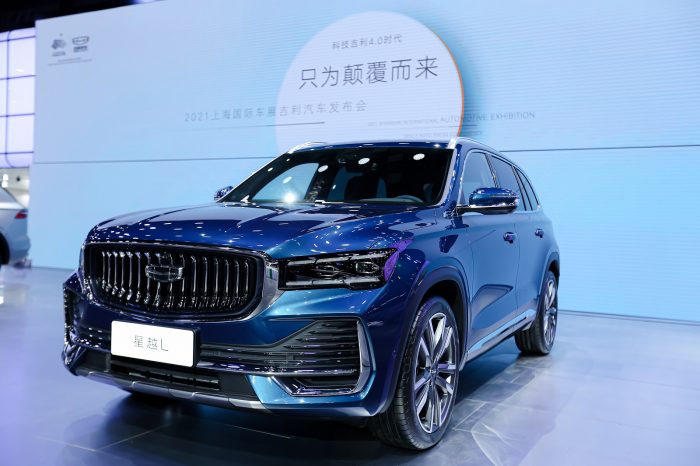For the first time the presentation of AUDI AG at Auto Shanghai 2021 is taking place with two partners at a shared trade-fair stand. Audi and its Chinese partner companies FAW and SAIC are showing no fewer than four world premieres: the brand-new Audi A6 e-tron concept vehicle and the all-round updated Audi Q5L, in… Continue reading @VW Group: Four world premieres and PPE technology – Audi at Auto Shanghai 2021002878
Category: OEMs
@Nissan: All-New Nissan X-TRAIL – coming to Europe next summer000310
All-new family model to arrive in Europe in summer 2022 Based on Alliance CMF-C platform, more versatility, convenience and comfort will be standard To be equipped at launch timing with Nissan’s innovative e-POWER powertrain PARIS – To complement Nissan’s range of striking crossovers, next summer (2022) will see the introduction of the all-new X-Trail, whose world… Continue reading @Nissan: All-New Nissan X-TRAIL – coming to Europe next summer000310
@Nissan: Nissan X-TRAIL – coming to Europe next summer000310
2021/04/19 All-new family SUV to arrive in Europe in summer 2022 Based on Alliance CMF-C platform, more versatility, convenience and comfort will be standard To be equipped at launch timing with Nissan’s innovative e-POWER powertrain PARIS – To complement Nissan’s range of striking crossovers, next summer (2022) will see the introduction of the all-new X-Trail… Continue reading @Nissan: Nissan X-TRAIL – coming to Europe next summer000310
@Ford: Lincoln China Debuts Zephyr Reflection Preview Car; Introduces Corsair PHEV at Auto Shanghai 2021
Lincoln Zephyr Reflection preview car makes its debut at Auto Shanghai; showcases expressive and vibrant exterior, serene and technology-forward interior for the China market Locally produced all-new Lincoln Corsair PHEV, debuts as Lincoln’s first new energy vehicle in China Breakthrough Lincoln ID launches with single, seamless access across all digital touchpoints to further enhance the… Continue reading @Ford: Lincoln China Debuts Zephyr Reflection Preview Car; Introduces Corsair PHEV at Auto Shanghai 2021
@Geely: Geely Unveils Latest High-End Flagship SUV – Xingyue L
Geely Auto unveils latest CMA-based flagship SUV, Xingyue L with new “Symphony of Space and Time” aesthetic Premium SUV highlights symphony between Eastern and Western styling Empowered by advanced technologies to offer a luxurious user experience First Geely model to go beyond L2 autonomy with 100% automated valet system, enabling the car to search for… Continue reading @Geely: Geely Unveils Latest High-End Flagship SUV – Xingyue L
@Daimler: Electromobility in a family package: the new EQB at a glance
Room for sevenAs a seven-seater (optional), the new EQB offers space for many family constellations and a wide variety of transport needs. This gives it an exceptional position among electric cars. The two seats in the third row can be used by people up to 1.65 metres tall, and child seats can also be fitted… Continue reading @Daimler: Electromobility in a family package: the new EQB at a glance
@VW Group: Automobili Lamborghini: sales soaring, record first quarter002875
Sant’Agata Bolognese, April 16, 2021 – Automobili Lamborghini closes the first quarter of 2021 with another record achieved. The Sant’Agata Bolognese super sports manufacturer delivered 2,422 cars from January to March, marking its best results ever. The increase in sales was +25% over the same period of 2020 and is 22% higher than the first… Continue reading @VW Group: Automobili Lamborghini: sales soaring, record first quarter002875
@VW Group: E-offensive in China continues to gain momentum: World premiere of the ID.6(((ID.6 CROZZ/ID.6 X – The car will not be available in Germany.)))002875
The Volkswagen brand is driving its electrification offensive in China at full speed. The third model in the ID. family, the ID.6, has now been unveiled at the Auto Shanghai. Two versions of the fully electric family SUV are available: The ID.6 CROZZ is being manufactured in the north of China and the ID.6 X… Continue reading @VW Group: E-offensive in China continues to gain momentum: World premiere of the ID.6(((ID.6 CROZZ/ID.6 X – The car will not be available in Germany.)))002875
Mercedes Explains Why The 2022 EQS Still Has Traditional Mirrors – Motor1
As you would expect from an absolute EV flagship with a six-figure price tag, the Mercedes EQS is brimming with tech. From its powerful dual-motor AWD setup to the 56-inch Hyperscreen, the fullsize luxury sedan is worthy of its status as the S-Class of electric cars. That said, some would argue there’s one glaring omission… Continue reading Mercedes Explains Why The 2022 EQS Still Has Traditional Mirrors – Motor1
@VW Group: Porsche significantly increases deliveries in the first quarter of 2021002872
The Porsche Newsroom is a service provided by the Porsche Communication for journalists, bloggers and the online community. © 2021 Dr. Ing. h.c. F. Porsche AG * Data determined in accordance with the measurement method required by law. Since 1 September 2017 certain new cars have been type approved in accordance with the Worldwide Harmonised Light Vehicles… Continue reading @VW Group: Porsche significantly increases deliveries in the first quarter of 2021002872
